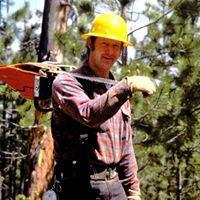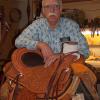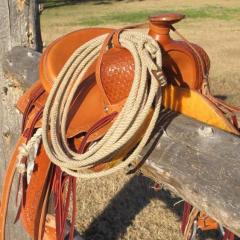-
Content Count
105 -
Joined
-
Last visited
About Wyowally
-
Rank
Member
- Birthday 02/15/1947
Profile Information
-
Gender
Male
-
Location
Torrington Wyoming
-
Interests
Vintage sewing machines;Camping, hunting, fishing.
LW Info
-
Leatherwork Specialty
sheaths
-
Interested in learning about
sewing machines
-
How did you find leatherworker.net?
web searching
Recent Profile Visitors
3,422 profile views
-
Wyowally started following Singer 111w155 thickness of leather it can sew, ten round bullet pouches, Singer 111W155 Rehab and and 6 others
-
I get scraps from a saddlemaker friend frequently. I made some cartridge holders, and learning the loops for different size cartridges is challenging. What I did find out - and should have known - is that you've got to be careful about long term storage. Some of the chemicals in the leather will start corrosion on brass cases. It takes a while, but will start sucking the copper out of the brass. Not good!!
-
I actually bought a new replacement eccentric just so I could understand how they're designed to work. Never had to install it though.
-
I use that Coats thread that was posted with a price earlier. That's about twice or more what I pay, BTW. $3.79 a spool if I buy 3.
-

FNG Seeking to clarify mixed messages...
Wyowally replied to Ripper70's topic in Leather Sewing Machines
I commend you for your approach and attitude about learning. I'm sure you will progress quickly. The advice you get from the regulars here is spot on! I know from my own experience. You found the right place - I see so much misinformation and bad advice in some of the FB groups that I just shake my head, now that even I know better.- 13 replies
-
- class 26
- twist point
-
(and 2 more)
Tagged with:
-

Singer 111G156 saved from landfill
Wyowally replied to johnnysingerfan's topic in Leather Sewing Machines
I did get aftermarket decals. Not exactly original, but close enough for me. -
They do have a little foot that comes down the back of the presser foot and helps pull material somewhat, so that makes them a little more capable vs. the plastic shell price leaders being sold today. Still, they are what the others on here have told you. There is a "vintage Pfaff sewing machines" FB group that is pretty active. It is discussed there. They have manuals in their Files section too.
-

Safety Clutch settings, Adler and others
Wyowally replied to Wyowally's topic in Leather Sewing Machines
I am smiling because it seems that there are no real adjustment instructions. If it kicks out when you don't want it to when sewing nothing out of the ordinary - then tighten it up a little. If it still kicks out, tighten it some more. If it doesn't kick out when you break a needle or get one of those multiple thread tangles around the bobbin/hook - loosen it up some and hope it works. At least that's what I have found out so far. YMMV. -

Safety Clutch settings, Adler and others
Wyowally replied to Wyowally's topic in Leather Sewing Machines
I never asked for specifics on the actual adjustment in that thread. I do have it cleaned, aligned, and lubed and it does disengage with what I think is adequate force after that and backing the adjustment screw way off. Just find it sort of amusing that the manufacturers who will specify something like "0.35mm clearance" have provided an adjustment without actual adjusting instructions. For this machine I will set it so it trips when a #25 needle hits 1/2" of hard veg tan when trying to force the needle through with the hand wheel. I'll report in this thread on that experiment. -
I got the Adler 167-gk373 working pretty well after all the feedback from you folks. Thanks! I think the safety clutch was the culprit - not releasing easily or as designed. I have searched here and elsewhere on what the trip settings should be - as in if there is a need to adjust, how to do that. Is there an actual torque number, or is it more a ballpark range sort of thing? Maybe back it way off to the soft side, then if it trips too easily when just sewing on tough material with big needle and thread - tighten it up a little? Or put a block of wood under the needlebar (without needle), then adjust to trip when turning with the handwheel with what seems like too much force? I hope that explains my question. The machine mentioned did have the clutch locked up, so the needlebar moved in the clamp, the screw tips got hardened and polished to where the clamp wouldn't hold well when doing normal sewing. Fixed that. Thanks again.
-
Interesting data and manual if indeed that's the OP's machine. IF it is, the manual says that thread tension will be released when the thread trimmer does it's thing. The cable is related to that trimmer, and is part #36 in the listing, calling it a "thread tension release wire". IF it is the machine, the wire doesn't come into use until the trimmer is used then. Now if I could just learn to sew.
-

Singer 111w155 thickness of leather it can sew
Wyowally replied to Davidmadd's topic in Leather Sewing Machines
What Wiz says for sure. I was dealing with a similar issue on a different model not long ago. Just for giggles I hand threaded a #23 leather needle with 138 bonded nylon. Then I put the needle butt down on my bench and pushed a couple pieces of 4 oz. veg tan down on the needle point. It took a LOT of force! After it went through I pulled it back a little and put another thread through the loop. Then started pulling the needle back up while holding the leather down. Again, it took an amazing amount of force to pull the needle, loop, and "bobbin" thread back up and into the leather. There is a huge amount of friction - I think the forces involved are much more than at least I was aware. What it all means to me that if the needle is not large enough for the thread, then the thread will suffer. 92 bonded nylon with the same needle was a much better match. -
45 mm. It takes a different belt of course. I measured carefully and guessed belt size with the counter guy at my auto parts store. Made a lucky guess. Pulley from AMZ.
-
Don, thanks! I also thought the socket head screws seemed out of place. I might pull one and check the thread pitch and type just for curiosity. I try to get all the original adjustment info I can, but still rely heavily on you, Uwe, Constabulary and others. I had my upholstery buddy come over and test run this one with various materials, speeds, forward/reverse shifts and all. He gave it his seal of approval. It is fun to watch a pro!
-
I studied this clutch in depth today. What I found: Both shafts have a flat that one of the pair of set screws is designed to engage. I found no marks or information that told me which screw of the pair to engage the flat with. The four screws are identical. Looking at the clutch and rotating, I put the screw in the upper hole when the other one is exposed below it, on both sides. What I found for adjustment is a screw visible through one of the holes in the outer collar when it is disengaged!! I was able to adjust. Although there is huge potential for changing the timing by selecting the wrong screw to engage the flat, either side, I got lucky and my installation didn't change timing. The timing must be checked for sure though, because it will change if the screws that engage the flats are changed around. It is working well, and I am pleased with the disengagement torque. The picture shows the adjustment screw visible through the outer collar - the hole is normally filled by the engagement ball, so if you start looking for any adjustment location while the clutch is engaged (like I did) you wont find anything. I never found a book or manual reference showing exactly this.
-
Quade and Glenn, thanks for your input. I have it working very well right now - but still puzzled. Quade, I think your suspicions about the clutch components slipping on the shafts and cutouts may be correct and I'll check that today. Not sure about flats or cutouts and want to know. I think in order for things to get out of time and needlebar height change there had to be some force involved that setscrews couldn't hold back. I started at the belt pulley and made sure screws and setscrews were tight. Before, I had re-engaged the clutch, but it had taken more force than I thought it should. I loosened but didn't back off all four setscrews in the two clutch components and oiled the balls and mating surfaces thoroughly. Then just snugged the screws and forced disengaging and engaging and spun the two around a number of times. Tightened the screws and did the same. It works much better . Don't know if there is a torque spec, but it seems reasonable now. Went on towards the hook, making sure screws were tight and lateral movement was proper. Popped the gearbox cover knowing timing was way off. Discovered too much backlash movement in the hook gear. Timed it for hook needle alignment with needlebar 1.75mm rise, then made sure shaft to hook gear backlash was minimized without binding. Re-set the needlebar height to specs. I wonder if the tips of those screws don't get smoothed and hardened after several cycles of jamming, needle breakage, etc. I'll check that. Made sure the case opener had proper clearance when moved to the right. It was a little too fine, not quite the gap it should show for heavier thread. Sewed perfectly after all this. I still want to know more about what can happen if the clutch doesn't turn loose when it should - but I'm pretty sure I may not ever. For now the previous owners, Bubba and his pipe wrench, thread jams and broken needles are all likely suspects in causing the timing changes I discovered. If I make any discoveries after checking the shafts for cutouts I will let you know!





